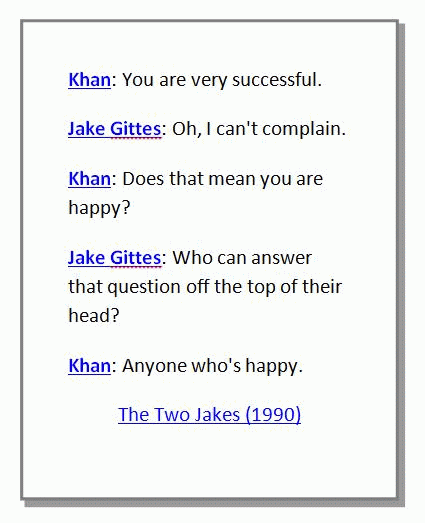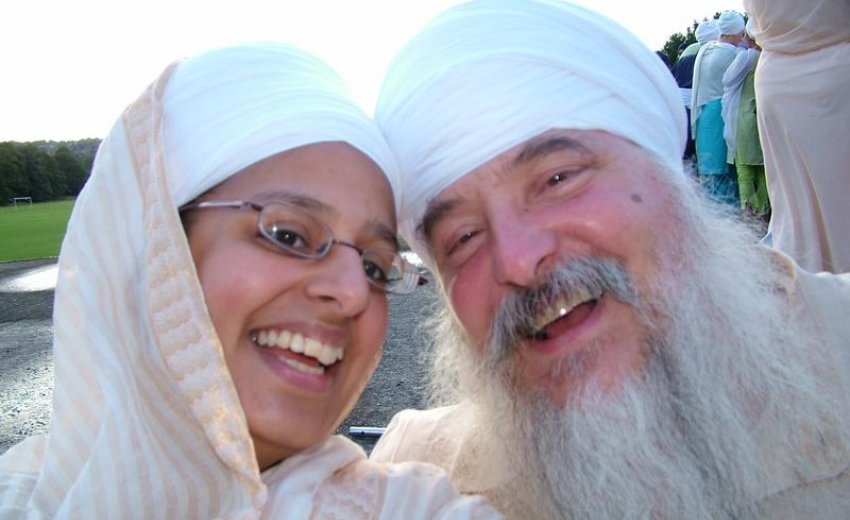In the United States, the right to the pursuit of happiness is guaranteed to us in the Bill of Rights. Mind you it is the pursuit and the opportunity that are promised, not the actual delivery of it. Don’t we need a sense of what is or is not happiness before — mindfully or mindlessly — we go running after it?
 What exactly is happiness? This is not just a rhetorical question. We think we know when we have it and also when
it has been stolen or denied. The past can
be instructive. Sometimes what seems
wonderful at the time turns out not to be so after all, and what seemed to be
awful at the time turns out wonderfully after all.
What exactly is happiness? This is not just a rhetorical question. We think we know when we have it and also when
it has been stolen or denied. The past can
be instructive. Sometimes what seems
wonderful at the time turns out not to be so after all, and what seemed to be
awful at the time turns out wonderfully after all.
As Oscar Wilde put it: “There are only two tragedies in life: one is not getting what one wants, and the other is getting it.” The second alternative may be the worse of the two. Not getting what one wants may be more desirable over time for it may keep efforts and hopes alive.
Isn’t
happiness the key to life, indeed its foundation? Debate on what happiness is, and how to
define and attain it, has kept our best minds busy for as long as we have had
the conscious faculty to dream, hope, or be disappointed.
For happiness, Aristotle prescribed a triad of pleasure, honor and self-sufficiency. Humans, he claimed, feel pleasure when they do “good” and they pursue honor in order to feel satisfied that what they do is good. This sounds somewhat tautological and circular reasoning. But this is how we reassure ourselves that we are living up to the full potential of our virtues. Happiness then is the sense of living life to its fullest potential.
Does this mean that immature people, not having lived a full life, can neither be fully happy nor unhappy? Aristotle seems to reason so.
From such arm chair head games let’s move to empirical data on the slippery idea of happiness. From the slew of sociologists, behavioral scientists and psychoanalysts in the field, I note two here: Edward Diener and Sonja Lyubomir. But conceptual and definitional difficulties remain.
Correlations exist between happiness and social, economic and personal milestones but mixed results face us: wealth, beauty, and fleeting pleasure are unrelated to general happiness, as are serious illness or marriage. One must then reject the idea of collecting toys to ensure happiness as many people do. Cultural psychobabble continues to bless us with “how to” books on happiness but they seem of limited value. Just peruse Psychology Today to see the many ways, behavioral and pharmacologic, that the human mind has invented to find happiness.
Methodological challenges exist when relying on questionnaires to objectify what is a subjective and elusive experience. When a person claims to be happy does he mean that he is not in pain now as opposed to an hour or a day ago or that he is in pain but has learned to transcend it? Do the questioner and the respondent have a common understanding of “pain and pleasure” and of happiness as a goal of life? Nevertheless, oodles of empirical data have generated almost an industry of self-help books and talking heads on the tube.
Philosophy and empirical disciplines ask us to wrestle with hypotheses. If pleasure is the key to happiness, John Stuart Mill asks us to distinguish between the sensory and the more intellectual pleasures (Is this a hierarchy of pleasures?), while Robert Nozick suggests that by attaching ourselves to a device that produces constant pleasure, we would attain this goal even if we achieved nothing else in life except such never ending intense pleasure. The role of oxytocin and dopamine, among others, in experiencing happiness has been widely explored. Someday I hope to prevail on a maven of this field; the Nova Scotia based Dr. Surinder Singh Sodhi, to provide a fuller discussion on biochemical mechanisms of mind altering phenomena.
However, Immanuel Kant posits that the goal of life should be not happiness but choosing to do the right thing, even if it puts our happiness at risk. I am not going to step into the quagmire of defining what the right thing is. Moreover, the prophets of nothingness, Nietzsche and Sartre, would likely question whether morality by itself is a goal that justifies human existence.
Notice that the philosophic discussions steer clear of perhaps the greatest molder of human behavior and that is religion or faith.
Recently Arthur C. Brooks, President of the American Enterprise Institute, in an OP-ED in The New York Times boiled down our age old debate on happiness to a few salient human requirements that make a stable 4-legged stool: Faith, Family, Friendship and Work. Sounds simple but, as with most matters that seem self-evident, the devil is in the details.
The four markers of Brooks are loaded with meaning. I aim to extend their meaning from the Sikh perspective. Each item deserves an independent essay and I have published some. Here I offer brief thumbnail notations on these key fundamentals of life that, according to Brooks, form the four pillars of happiness.
Faith can move mountains and it has. Faith has worked its magic; it has been responsible for more good in the world than anything else but it has also set off more death, destruction and evil than anything else in human history.
Faith does the most good when it leans on something bigger than the self and that’s the fundamental Sikh teaching when it asks us to uproot our ego and destroy it. Sikh teaching posits a paradox. Ego, or better yet narcissism, it says, is the supreme affliction of mankind; and its panacea lies within the disease -- Haumae deeragh roag hae daroo bhee iss mahay, (Guru Granth, p 466). To submerge the self in a cause larger than the self is then the way out of this dilemma (Guru Granth, p. 474: “Aap gavaaye seva karay taaN kitch paaye maan”). That’s the only way to kill the ego that is perhaps better labeled narcissism; a word that is not yet in Sikh lexicon but it should be. (This significant switch in terminology stems from a conversation with my friend Harbans Lal.) It is then that faith defines a life, becomes inclusive and tolerant; not exclusive, dogmatic, self-righteous and hateful.
Sidney Blatt, a celebrated Freudian, looks at humans as having a dual identity (nature) at their core — two dimensions to a sense of self: one, a concept of a personal identity, and secondly, a communal identity. Dissonance between the two produces clinical depression and psychoses. This emphasizes how essential the bonds of community are; they likely stem from the fact that humans are too fragile to survive or thrive without a family or tribe. The community helps define the self; and in the community one can transcend the self as well.
Yes, there are fences between religions, as they exist between the best neighbors, but never should they become walls that seal one from the other. Heightened claims of exclusivity as commonly interpreted in Judeo-Christian-Islamic faiths only diminish the non-Abrahamic faiths; they create a divisive world, not one that embraces humanity with respect for the variety that exists amongst them. It’s more productive to keep some lines from Guru Granth in mind: (Here I provide the starting line of the citation in the original language and the rest of the text in serviceable English.)
Sarab dharam meh srest dharam
“Of all religions, the best religion is to utter the Holy Name with love and do good deeds;
Of all temples, the most sacred is (Says Nanak) the heart in which God dwells” (Guru Granth p 266; Sukhmani Astpadi 3, Pauri 8)
Guru Gobind Singh looks at the variety of humanity with a very kind and generous eye:
Jaise ek aag te kanuka kot aag utthai
“As out of a single fire millions of sparks arise
They arise in separation but come together again when they fall back in the fire.” (Akal Ustat, 87)
That’s why in Sikh teaching the attributes of God are endless; that’s why the Creator is omnipresent, omnipotent, and infinite, free of birth and death; and has no gender, color, caste, creed or form. The Creator must and does transcend human imagination that is limited to the finite dimensions. And that’s why the Sikh scripture, Guru Granth, assigns no particular name to the Creator and that’s exactly why Jaap Sahib, a composition by Guru Gobind Singh for daily recitation by Sikhs, gives an almost endless list of names that humans have used to enshrine the Creator in the human heart. Yet, it is the same one God that’s common to all humanity (“Aval Allah noor upaya kudrat ke subh banday” Guru Granth p.1349).
Finally, that’s why Sikhi speaks of the Ultimate Reality as one that our senses cannot fully perceive nor one that our intellect can ever entirely fathom but one that our inner self can commune with.
Family, of course! We come into the world with one and can barely survive for long without it. But what is family? Blood relations! They remain fickle; Abel and Cain, the first brothers in mankind, according to the Old Testament, were not good for each other. Human history is awash with family feuds where blood flowed like water. The better and more profitable relationship is not of blood lines but of worldview and lifestyle. I cite Condoleezza Rice who sees the American nation as a “people forged not from common blood but from common purpose.” To me Sikhs and Sikhi fit that definition. Sikhi especially promotes this idea of family, community and religious nation as fundamental to identity. In Sikh parlance Sikhs have been enjoined to refer to each other as “Gurbhai” meaning a brother in faith.
Friendship, too, demands some interpretation. The company one keeps is important. In life what I wish for is the camaraderie of fellow travelers — those who do not rob me of my solitude without giving me company. The Sikh savant, Bhai Gurdas, reminds us that some company will liberate us, while other associations consign us to everlasting hell ("Kahoo ki sangat mil jeevan mukt hoei, kahoo ki sangat mil jum pur jaat hae."). An obvious truism is that we learn more from our peers than musty books. Sangat in Sikh teaching is not a random collection of people sitting in the same physical space in a prayer hall, each in his own microcosm. Sangat is a dynamic organic presence, an entity with the capacity to shape character and destiny.
Remember that all company may or may not be transformational or good. Kabir warns us that we become the company we keep (Jo jaisee sangat milay so taiso phal khaaye, Guru Granth p 1369).
Work: What would we do without work as the organizing principle of life? Work serves a far greater purpose than just putting food on the table.
At birth we inherit an imperfect world. We come into a world with all its technological marvels and also war and pestilence. These are our inheritance – the good, the bad and the ugly. It is these that give us the lifestyle that we enjoy or rue. How to pay our debt and to whom? To the creation around us we owe and that’s where we pay by leaving the world a little better, even an iota more than what we found when we came.
I emphasize here that Sikhi presents us a stable 3-legged stool as the framework for its way of life: an honest living, sharing of life’s rewards with the needy, and the driving of both these practices with an awareness of the Infinite within us. Says the Guru Granth (p. 25): Vich duniya sev kamaaye taN dargeh baesan paaye.
Happiness then is a state of mind; perhaps a better word for it would be, not contentment, but Sehaj. Contentment may only stem reluctantly from a lack of opportunity; sehaj, akin to the attitude of stoicism, is the eye that finds joy and sorrow like two robes in the wardrobe that each of us must wear with good cheer (Sukh dukh doi dar kapray pehray aye manukh, Guru Granth p. 149). It means also to turn a blind eye to the roaring success of others as well their sins.
Normally I adore analogies and metaphors but I am somewhat stumped in coming up with a suitable representation of sehaj. It has been simplistically rendered as “centered” in the language of the 1960’s or as “equipoise” as in being subtly balanced. Perhaps it is like the total calm within the eye of a tropical storm at its dead center. It is the single-mindedness in action and steady as still waters that run deep. Guru Granth speaks repeatedly of such a life as imbued with an inner bliss (anand) that is attainable with effort and grace.
Such an outlook speaks of the time-old prayer of St. Francis asking for strength to change the things we can, the serenity to accept what we cannot change and the wisdom to know the difference; this last being the hardest to learn. But it means to live life fully in the present — to live each moment with a clear mind and accept the outcome without regret. Sikhs call this a life in Hukum, to walk in the shadow of the Creator, since life is a gift of grace, not a sense of entitlement. This then asks us to find liberation in the midst of a joyful productive and full life (Guru Granth p 815 “Uddam karat anand bhaiyah simrat sukh saar;”and again p. 522 “hasandiaN, khelandiaN pehnandiaN khavindiaN vitchay hovae mukt”)
A life then becomes one that is prepared to make lemonade if reality serves you a lemon — in essence “Chardi Kalaa.” Pericles, a philosophic minded Greek general, who lived around 495 BCE, may have got it right. He reputedly said: The secret of happiness is freedom; the secret of freedom is a brave heart.
As my friend, Manjyot Kaur, succinctly put it, happiness is finding a place and a purpose in life. What character traits favor a happy, fulfilled life? Ask Harvard psychiatrist George Vaillant and he’ll tell you that one of the most powerful is generativity — the ability to give to others in a way that ultimately inspires and illuminates, passing on the torch of life and creativity. Generativity, says Vaillant, is grounded in unconditional love, because it gives without expecting anything back.
And then heaven lies in knowing ‘Quantum in me fuit’ — that I did the best I could.






